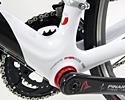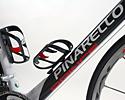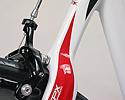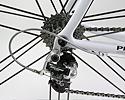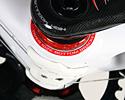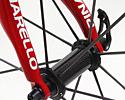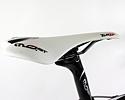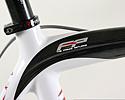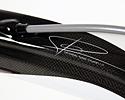
Recently on Cyclingnews.com |
On Test: Pinarello Prince FPX Carbon, February 27, 2008
Prince and the Revolution
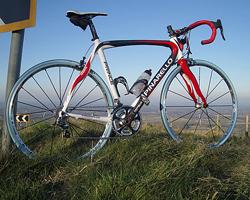
|
In the days before Lance Armstrong, the perennial Tour-winning machine was a Pinarello. In fact, between Stephen Roche's victory in 1987 and Marco Pantani's in 1998, Greg LeMond was the only man to win without one (twice). For this reason alone, a new Pinarello has to be at the top of most cyclists' wish list. The Treviso company launched its new flagship model this summer and Cyclingnews' Ben Atkins spends a couple of months with one to see if it can possibly live up to its billing.
My Name is Prince
We last saw Pinarello's Prince in 2005; in those days it was the company's top of the range aluminium frame with carbon seat stays. The standard Prince was retired at the end of 2004 as it was eclipsed in the range by the magnesium-tubed Dogma, but an LS model with the new Onda wavy fork system hung on for another year.
The New Power Generation
After a two-year hiatus, the Prince has now returned in an entirely new form. The frame has been used by Bala Verde (Green Bullet) Alejandro Valverde and his Caisse d'Epargne team since June's Dauphiné Libéré where we first spotted it, but the frame is only now available to the public.
In contrast to the Prince's previous incarnations, Pinarello has rejected aluminium in favour of a full carbon monocoque. According to Pinarello, its bicycle industry exclusive use of Torayca's advanced 50HM1K material allows for a lighter and stronger frame than before. Aluminium is reserved for only a handful of hard points, such as the small plates that reinforce the front and rear dropouts. The rear derailleur hanger is also carbon and non-replaceable. Pinarello verified that the latter is a feature on all production models (our tester is a team issue machine) as its designers feel the solid one-piece construction is both lighter and stiffer.
The frame's styling kicks Pinarello's existing Onda FP theme up a notch with the even curvier Onda FPX. The curves of the fork and seat stays have been continued on to the main triangle which uses a fairly traditional non-sloping geometry but with a slightly bowed top tube. The main triangle's other members are straight and true, including a round seat tube and a massive 'D'-shaped down tube. The asymmetric chain stays join the front triangle in a simply enormous bottom bracket area housing a standard Italian-threaded bottom bracket sleeve. Stiffening ribs are featured in strategic areas throughout the frame to counteract the thinner tubes.
Pinarello has also equipped the new Prince with the same full-carbon tapered steerer tube as on the Dogma FP whereby the standard 1 1/8" diameter up top widens to 1 1/4" at the fork crown. This arrangement isn't quite as radical as the 1 1/8"-to-1 1/2" sizing used by some others but still theoretically adds stiffness to the front end. The head tube is likewise enlarged and also fitted with additional waves and ribbing.
Sign o' the Times
Our Prince tester looked fast straight out of the box what with its curvy styling, swatches of visible 1K carbon weave and 2007 Caisse d'Epargne team red-and-white livery. Our Prince was built up with a complete Campagnolo Record groupset from Pinarello's Veneto neighbours with the exception of a Pinarello Tank FP carbon compact chainset that looks to have been made by FSA. Titanium coloured Campagnolo Shamal Ultra wheels are shod with a Prince-edition pair of Black Chili-fortified Continental Attack and Force clinchers.
The remainder of the finishing kit comes from Pinarello's in-house MOst brand, including the Lion Air and Tiger Lite carbon bar and stem combination, Tail carbon seatpost and XLR XP saddle. Rounding out the build are two 66mm-standard MOst carbon bottle cages and a pair of Pinarello branded Look Carbon KeO pedals. All this adds up to a complete bike weight of 6.95kg (15.3lb), just enough to keep Pat McQuaid happy.
Frame geometry on our 55cm sample is classic racer, including a 557mm-long top tube, 72.8° and 73.4° head- and seat tube angles and a 43mm fork rake. Relatively short 408mm chain stays yield a racy wheelbase of 995mm.
Let's Go Crazy
Pinarello designed this bike from the outset to be a racer and with the stem slammed right down on top of the headset, we'd have to say the result equals the original vision: out on the road, the Prince demanded to be raced at all times. The oversized tubes produce as stiff a frame as this tester has ever ridden and those asymmetric chain stays worked together with the huge bottom bracket cluster to efficiently transfer power. Likewise the front end showed virtually no signs of yielding during sprints or when attacking short climbs. At the same time though, the wavy bits at both the front and rear contrived to remove a lot of the sting from the irregularities of the country lanes of my usual training routes.
Climbing will never be what you could call a dream for this particular reviewer, but the Prince frame's stiffness - and the overall rigidity of the complete package - certainly made going uphill much less of a nightmare. In fact the feather light nature of the bike, together with that rigidity, meant that I found myself tackling many of the familiar hills in noticeably taller gears than usual - sometimes even in the big ring!
The Prince geometry really came into its own on the way down where years of experience have obviously paid strong dividends for Pinarello. The sureness and predictability of the Onda FPX forks together with the aggressive wheelbase offered agile handling in technical or tight corners along with the confidence-inspiring tire patch feedback that only comes from a well-tuned frame. The Black Chilli compound in the specially monogrammed tyres made this all the more easy by sticking themselves to the road very well.
I just want your extra time…
Campagnolo Record hasn't changed much for 2008 - except for the front derailleur, which now fits both standard and compact chainsets without needing a change - but it seems to be getting better and better regardless. Shifting proved somewhat light at all times, though, so much so that it's not really surprising that some pros asked for levers with stronger return and detent springs. There's not really much else to say about it, except that the Tank chainset worked flawlessly with the rest of the group.
The Shamal Ultra wheels proved to be nice and stiff without managing to be too harsh but the frame's curves always seemed to step in to take the sting out of things, anyway. We eventually swapped out the Shamal Ultra hoops for our Mavic R-SYS reference set to better isolate ride qualities. If anything they were even stiffer, but the ride still never felt at all harsh or uncomfortable.
The rest of finishing kit worked outstandingly. The MOst bar and stem felt as solid as could be and the cable channelling kept things nice and neat. The latter feature could prove cumbersome if you want to change the bars, however, given the frame's internally routed rear brake cable. In keeping with current fashion trends, the bar was taped only just past the hoods to show off the flattened top and flashy graphics. This proved a little slippery in practice, especially in the wet, so we quickly installed some fresh rolls of tape and wrapped them up to the usual location for better grip. The XLR XP saddle is basically a Selle Italia SLR and its familiar shape suited me well as it has done many times before.
The sole gripe with any of the kit on the bike was with the MOst carbon bottle cages. The smaller 66mm-diameter isn't all that common and while an Elite Bajiji bottle fit quite well, other types - also made by Elite - rattled quite annoyingly. I never lost a bottle, but the noise proved too much to bear especially since the rest of the bike was otherwise silent.
I was dreaming when I wrote this. Forgive me if it goes astray.
Much as we looked with fine-toothed comb and all, we can honestly say there's nothing about the new Pinarello Prince that we didn't like. Sure, you could admittedly buy a very capable bike for the price of just the frame and the looks are arguably a bit on the love-'em-or-hate-'em end of the spectrum. The non-replaceable derailleur hanger is a slight concern, but one that will have to be dealt with by only a very small fraction of consumers (even some ProTour teams specifically request bikes with non-replaceable hangers for their improved shifting performance).
Some bikes are built for climbing, some for sprinting, and some for long distances, but the Prince manages to excel in all these areas. The stiffness at both ends of the bike - especially considering its weight (or lack of it) - make it sure and true going upwards or downwards, and none of your power is wasted gunning for that finish line (or town sign). Despite this, the FPX wavy system at both ends takes a great deal of the sting out of the road, meaning you keep fresher for longer.
As with all Italian designer labels, there is a small suspicion that you're paying a bit of a premium for the name. That might hold a little extra true here but in this case the price delivers extraordinary all-around performance, brilliant handling traits that only come from generations of experience and some undeniable cachet.
Weight: 6.95kg (15.32lb)
Price: US$5000, GB£2699 (frame, fork, headset and seatpost)
Pros: Super stiff, super comfy, super everything! Italian designer kudos
Cons: Polarising looks may not appeal to all; Are you paying for the
name? Non-replaceable derailleur hanger
Cyclingnews rating: ![]()
More info: www.pinarello.com
Photography
For a thumbnail gallery of these images, click here
Images by Ben Atkins/Cyclingnews.com
- The Pinarello Prince FPX is a carbon fibre work of art.
- The main tubes meet in a massive bottom bracket area.
- The top tube meets the seat tube in a flowing joint with the rear monostay.
- Ribbing and sculpting makes the front of the head tube almost flat.
- The Prince's oversized down tube is 'D'-shaped in profile with an almost flat bottom.
- The triangular section top tube is bowed slightly in keeping with the rest of the bikes curves and waves.
- Another view of the top tube as it curves over to join the seat tube.
- In contrast to almost every other tube the seat tube is completely round in profile.
- The curvy seat stays ae joined to the seat tube via a slender monostay.
- Onda FPX is a further development of Pinarello's wavy system seat stays.
- The Prince has asymmetrical chain stays to better cope with the different loads each comes under.
- The new Onda FPX fork has ribs to further stiffen the narrow tube walls.
- The Record rear derailleur hangs from a non-replaceable carbon hanger.
- The Prince's curves make it one of this reviewer's aesthetically favourite bikes.
- The Record drivetrain is accompanied by a Pinarello limited edition TANK compact chainset.
- Pinarello's limited edition Tank compact chainset compliments the Record groupset perfectly.
- The Prince uses standard bottom bracket threading for use with most currently available chainsets.
- The new Record front derailleur will fit both standard and compact chainsets without having to be changed.
- The Pinarello head badge is one of the MOst desirable designer labels in cycling.
- The rear brake cable is routed internally to avoid it hanging below the bowed top tube.
- The Campagnolo Shamal Ultra wheels feature carbon fibre hubs.
- Like many wheels in the Campagnolo (and Fulcrum) range, Shamal Ultras have a two-to-one spoke ratio in favour of the drive side.
- Continental's Attack and Force tyres are graced with the Pinarello logo.
- The MOst Carbon 1K seat post is micro-adjustable and included in the price of the frame.
- The MOst XLR XP saddle is "not dissimilar" to a Selle Italia SLR.
- The MOst Tiger Lite carbon stem is light and stiff.
- The MOst Lion Air carbon bars feature a flat aero top section and tidy cable routing.
- 66mm-diameter MOst carbon bottle cages hold the bottles quite safely, but I did find that some rattled.
- The Prince Returns to the top of Pinarello's range after two years away.
- The non-driveside of the down tube has the same decals as the driveside, but in reverse.
- There's no getting away from reminders that this is a Pinarello Prince, or that it's made of some pretty special carbon fibre.
- Graphics everywhere! The city of Treviso is home to Pinarello and its crest adorns the underside of the down tube.
- Eldest son Fausto now heads the family firm but "Nani" Pinarello still puts his name to them.
- The Pinarello Prince is at home in any terrain and particularly excels in the hills.
- Pinarello provides the Prince to the team sponsored by Caisse d'Epargne - it's a French bank, by the way.
|
Frame: Pinarello Prince FPX monocoque in Torayca 50HM1K carbon
fibre |
Shift levers: Campagnolo Record QS Ergopower 10s |

